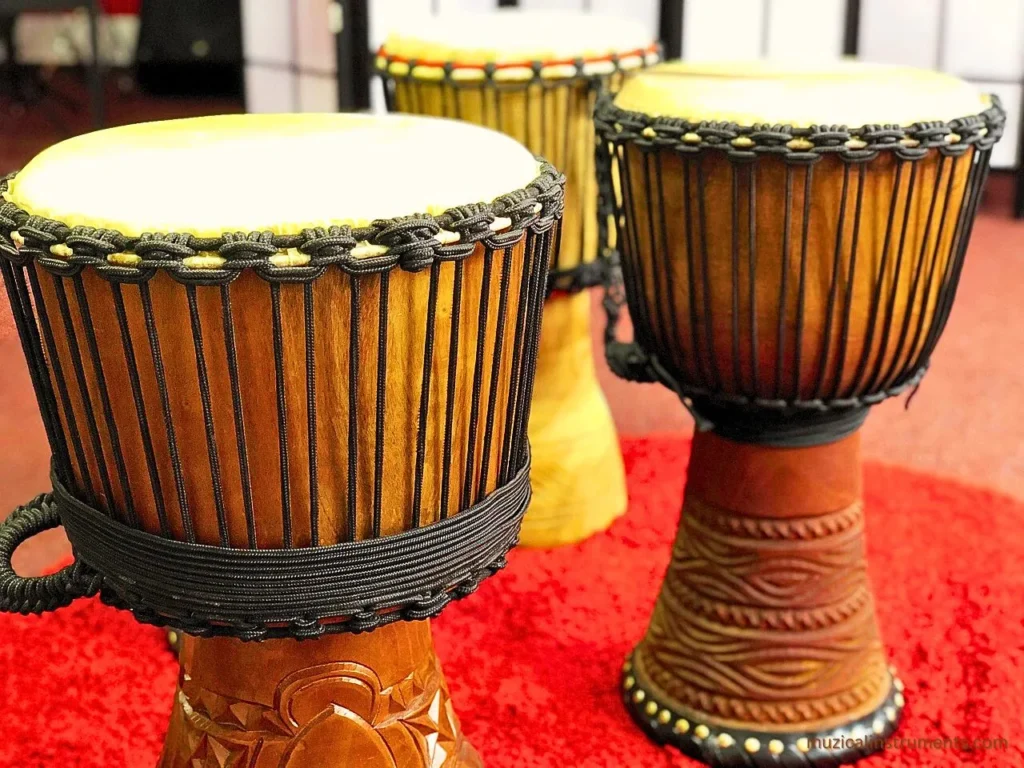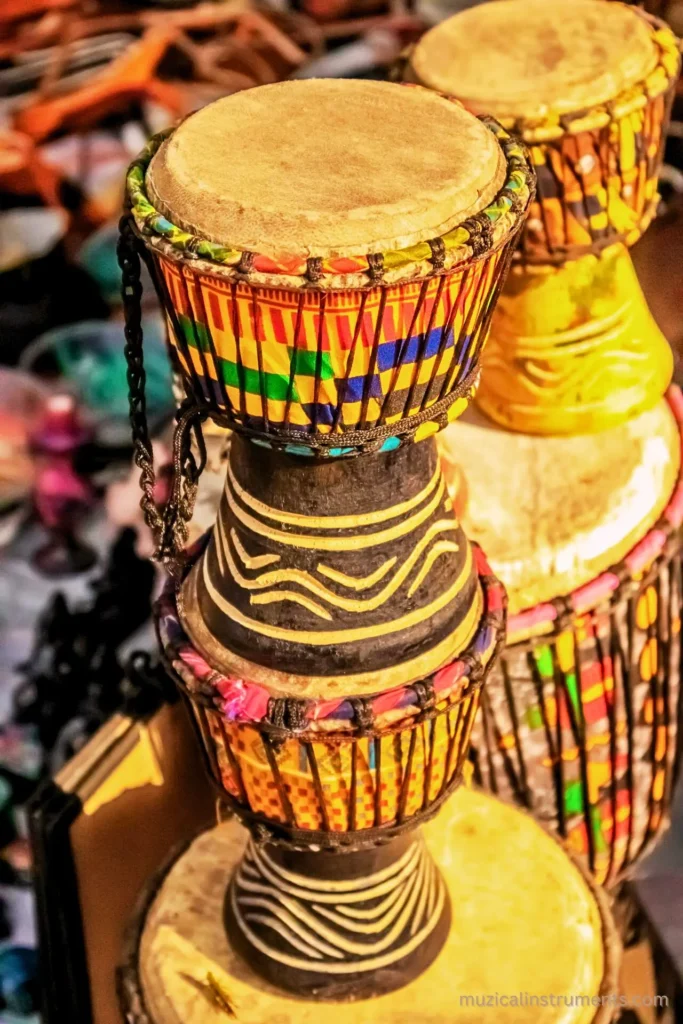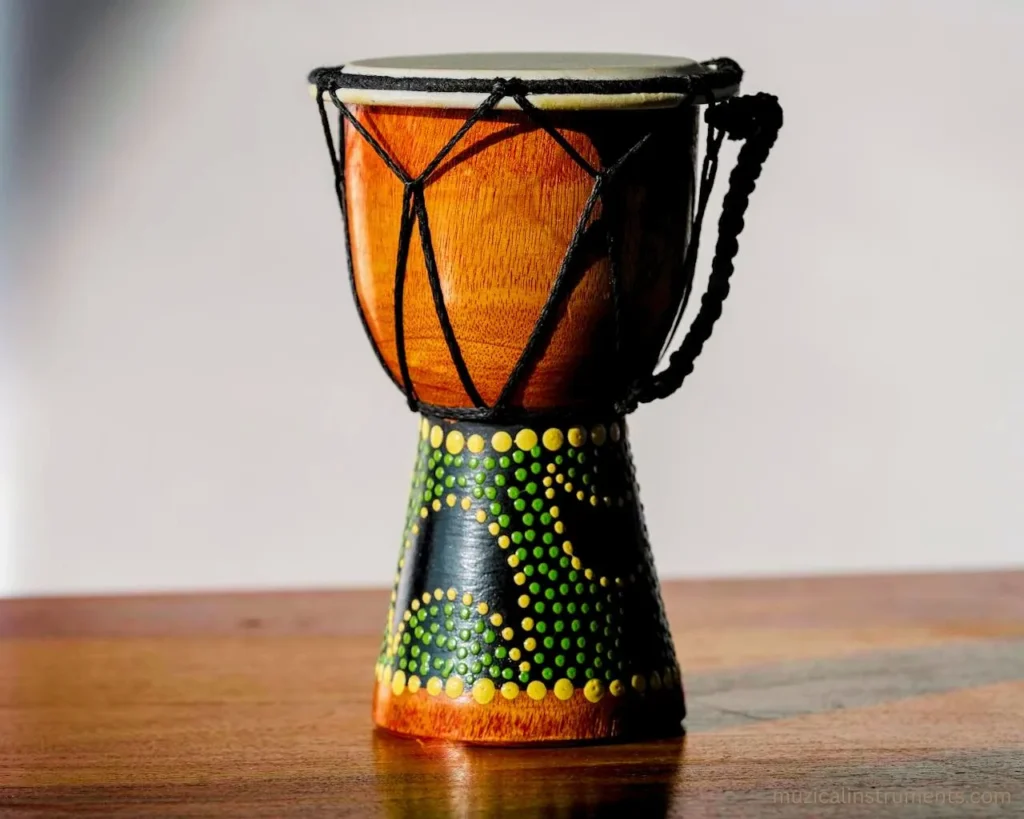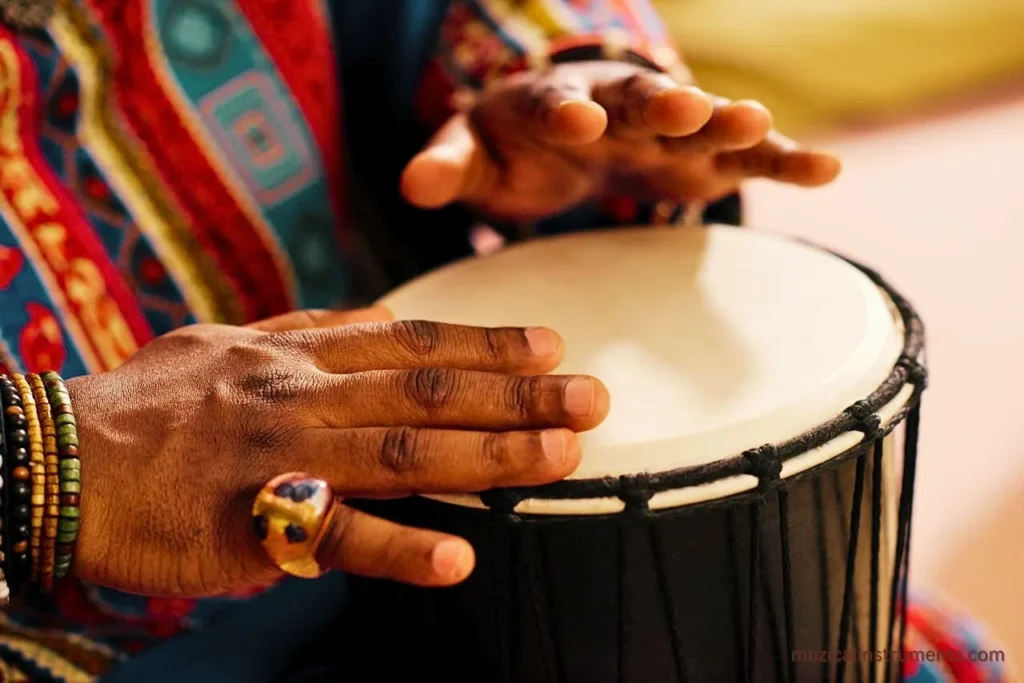The Spirits of the Djembe: Tree, Animal & Maker in Each Beat
The djembe is not just a drum. It’s something you feel. The djembe pulls you in for a reason. And the reason is the spirits of the djembe that live inside every beat you play.
It comes from the heart of West Africa, made by the Mandinka people during the old Mali Empire. Their Numu carvers shaped it from strong Lenke wood. They used goat skin for the head.
It is believed that each djembe holds three spirits. One from the tree, which it was carved from. One from the animal, whose skin used. One from the maker, who carved the wood.
Every time you play, those spirits move through you. If you want to truly connect with your djembe, you need to know what’s inside it.
The Origins Behind the Spirits of the Djembe
The djembe was born in West Africa. A long time ago, during the time of the Mali Empire, the Mandinka people made it part of daily life. It wasn’t just for music. It was for talking, healing, dancing, and calling people together. The drum was their voice.
But not everyone could make a djembe. Only the Numu caste, a group of blacksmiths and carvers, had that job. They believed the drum had to be made with care, heart, and skill. To them, the djembe held power. Real power. It was alive.
That’s where the three spirits come in. Each djembe carries a piece of life inside it: the spirit of the tree, the animal, and the maker. This belief still lives on today. When you play a djembe, you’re not just hitting a drum. You’re waking something ancient. You’re telling a story without words.
So before you play, it helps to know where your drum comes from. Because knowing the roots helps you feel the rhythm deeper. That’s how you play with soul, not just sound, embracing the very essence of the spirits of the djembe.
Spirit of the Tree: The Djembe’s First Life and Its Influence on the Spirits of the Djembe
Your djembe began as a tree. That’s where its first spirit comes from. In West Africa, drum makers choose trees with care. They don’t just cut any tree. They ask first. They thank the land. This is about respect.
One of the most loved woods is Lenke. It’s strong. It’s special. Some say Lenke carries healing energy. Others use iroko or mahogany, each with its own voice. The drum’s shape comes from one whole piece. Not glued. Not patched. Just one solid heart of wood.
The spirit of the tree stays in the drum. It gives the djembe its deep voice. Its base. Its body. When you play the low bass sound, that’s the tree speaking. That’s the earth talking back to you.

So the next time you hit your djembe, stop and listen. Feel the ground in the sound. That’s the first of the spirits of the djembe, alive and strong inside your hands.
Common Woods & Their Meaning
| Wood Type | Origin | Sound Quality | Spiritual Meaning |
|---|---|---|---|
| Lenke | Guinea | Deep, full | Healing, power |
| Iroko | Ivory Coast | Bold, warm | Protection |
| Mahogany | West Africa | Soft, mellow | Wisdom, peace |
Spirit of the Animal: The Voice of the Djembe and How it Shapes the Spirits of the Djembe
Now let’s talk about the skin. That’s where the second spirit lives. Most djembe drums are topped with goat skin. Not cow. Not plastic. Goat. Why? Because it gives the drum its voice, bright, sharp, full of life.

The animal matters. The sound changes with the goat’s age, the land it lived on, even how it moved. The spirit of that goat doesn’t disappear. It stays with the drum. When you play tones or slaps, that’s the animal speaking.
This part of the djembe is about feeling. You’re touching something that once ran, ate, and breathed. In African tradition, nothing is wasted. The goat’s spirit becomes music. It becomes joy. It becomes memory.
So treat your drum with care. Keep the skin tight. Keep it clean. And when you play, play with thanks. You’re sharing the voice of a real life, a vital component of the spirits of the djembe.
Goat Skins & Their Sound
| Goat Type | Sound Quality | Common Use |
|---|---|---|
| Mountain Goat | Tight, high | Fast solo slaps |
| Farm-raised Goat | Warm, round | Balanced rhythms |
| Wild African Goat | Bright, sharp | Traditional tone |
Spirit of the Maker: The Hands Behind the Djembe and Their Contribution to the Spirits of the Djembe
The third spirit lives in the hands that made your djembe. It comes from the maker, a carver, often from the Numu caste, who learned the skill from family, passed down through time. This is not factory work. This is heart work.

Each drum is shaped by hand. Every curve, every line, carved with care. No two djembes are the same, because no two carvers are the same. Their touch stays in the drum forever. You don’t just play wood, you play someone’s story.
In West Africa, making a djembe is sacred. The maker puts his spirit into the drum. His mood. His energy. His love. And when you play it, you bring that spirit to life again.
So when you pick up your djembe, think about the hands that made it. Think about the long hours. The focus. The pride. You’re not just playing a drum. You’re playing a bond between two people, you and the maker, embodying another facet of the spirits of the djembe.
Playing the Djembe: How the Spirits Speak Through Your Hands
Now that you know what lives inside your djembe, the tree, the animal, and the maker,you can feel it differently when you play. You’re not just hitting a drum. You’re letting the spirits of the djembe move through your hands.

In West Africa, playing the djembe is a way to speak. It tells stories. It calls people together. In a village, you’ll hear it at weddings, funerals, moon dances, and healing circles. It’s not just music. It’s a message.
The one who leads the rhythm is called a djembefola. That means “one who speaks with the drum.” But even if you’re just learning, the drum still speaks through you. Every sound you make comes from something deeper.
So the next time you sit with your djembe, pause. Feel the wood under your fingers. Listen to the voice in the skin. Respect the one who shaped it. Then play. Let the spirits of the djembe speak. Let them tell your story too.
Modern Echoes: How the Spirits of the Djembe Live On Today
The djembe has traveled far from its home in West Africa. Now you’ll find it in schools, circles, yoga studios, and street corners. But even far from the Mali Empire, its three spirits are still alive.
Some people just tap the drum. Others really feel it. That’s the difference. When you respect the tree, the animal, and the maker, your playing changes. It means more. You carry the old ways with you, even in a modern world.
Drummers today are keeping the traditions alive. They learn from African masters. They honor the roots. They listen more than they talk. And when they teach others, they pass on more than rhythms. They pass on stories. Spirits. Truth.
So if you play the djembe, anywhere, for any reason, know this: you are part of something old, powerful, and beautiful. Keep learning. Keep listening. And let those three spirits of the djembe move with you.
Traditional vs. Modern Djembe Uses
| Use Case | Traditional Setting | Modern Setting |
|---|---|---|
| Healing | Shamanic ceremony | Music therapy & wellness |
| Community Calling | Village gatherings | Drum circles & retreats |
| Teaching/Training | Apprenticeships | Online classes, schools |
Frequently Asked Questions (FAQ)
1. What are the spirits inside a djembe?
Each djembe truly holds three distinct spirits of the djembe: the spirit of the tree it was carved from, the spirit of the animal (specifically the goat) whose skin forms its head, and the spirit of the maker who meticulously carved and assembled it. These combined spirits of the djembe are believed to live within the drum and speak through your hands when you play.
2. Why do people call the djembe a spiritual instrument?
In West Africa, the djembe is far more than just a musical instrument; it’s deeply spiritual. It’s used in healing ceremonies, rituals tied to seasons, celebrations, and various forms of spirit work. The drum’s specific shape and resonant sound are believed to connect players and listeners to something much bigger than themselves, allowing the spirits of the djembe to facilitate these connections.
3. Who made the first djembe, and why does it matter for the spirits of the djembe?
The Mandinka (or Malinke) people of the ancient Mali Empire are credited with creating the first djembes. Importantly, only the Numu blacksmith-caste were traditionally permitted to carve them. This matters significantly because they believed each drum needed immense care, respect, and indeed, a strong infusion of spirit to function effectively. This meticulous process ensures the presence and power of the spirits of the djembe from its very inception.
4. Why goat skin and not other types is used for the djembe, and how it relates to the spirits of the djembe?
Goat skin is exclusively used for the djembe because it gives the drum its characteristic warm voice and lively tone. Beyond sound, it is believed to carry the very life and spirit of the animal who once lived. When you play, you’re not just making music; you’re sharing that life and honoring that aspect of the spirits of the djembe through sound.
5. Is the rope-tuning system new?
Yes! The rope system for tuning djembes became common relatively recently, in the late 1960s and 1970s. Before that, people traditionally used leather or strips from cows or deer to tension the drum head. This evolution in tuning methods doesn’t diminish the presence of the spirits of the djembe, but rather reflects an adaptation in construction.
6. Can the djembe teach you peace and joy through the spirits of the djembe?
For the Mandinka people, the drum is profoundly a way to share joy and peace. As Mamady Keïta, a renowned master drummer, beautifully expressed, the drum “helps us show … we can come together as people.” This coming together, this unity and positive energy, is often seen as a direct manifestation of the harmonious spirits of the djembe.
7. Does the djembe connect us to our ancestors through its spirits?
Yes, it is strongly believed that the drum can call on ancestral spirits. That’s precisely why it’s a central instrument in funerals, moon rituals, and healing circles. Its powerful rhythm is thought to carry messages to ancestors, facilitating a profound connection through the enduring spirits of the djembe.
Final Beat: Let the Djembe Speak Through You
The djembe is more than a drum. It’s a living thing. It holds three spirits, from the tree, the animal, and the maker. These spirits give the djembe its voice. And when you play, they speak through you.
Now you know the story. You know what your drum carries. So don’t just play for sound. Play with feeling. Play with thanks. Each beat is a gift. Each rhythm is a thread, connecting you to the past, to people, to something bigger.
The Djembe is powerful on its own, but it’s even stronger with the Dunun by its side. Learn what the Dunun drum is and how it supports the Djembe in traditional West African music.
